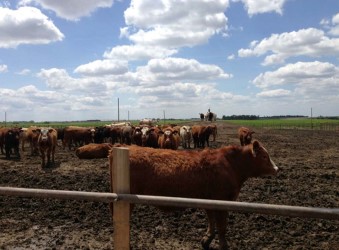Project Summary
Validation of Environmental Predictors of Salmonella Contamination in Feedlot Environments
- Principle Investigator(s):
- Dayna M. Brichta‐Harhay, Terrance M. Arthur, John W. Schmidt, Rong Wang, Norasak Kalchayanand, Mick Bosilevac, Tom Edrington, Guy Loneragan, Tommy Wheeler
- Institution(s):
- USDA, ARS, U.S. Meat Animal Research Center (USMARC)
- Completion Date:
- July 2014
Background
The foodborne pathogen Salmonella has been detected in peripheral lymph nodes (PLNs) of cattle at harvest. Fat trim containing lymph nodes may be a component of ground beef and has been identified as a potential source of Salmonella in this commodity. The mechanism of entry of Salmonella into bovine PLNs has yet to be determined, but it has been suggested that Salmonella present on cattle hides may be introduced through bites or wounds. Thus, identifying effective tools for assessing Salmonella levels in pre‐harvest environments is likely a key component to preventing infection of bovine tissues with this pathogen. Previous studies identified feedlot pen tank water and pen floor surface material as reliable sample types for the examination of Salmonella prevalence and levels in a given feedlot. Further, it was observed that aberrantly high levels of Salmonella contamination on cattle hides (defined as hides contaminated at ≥ 103 CFU/100 cm2) was related to peripheral lymph node contamination with Salmonella. The research reported here aimed to further examine the utility of these environmental samples for characterizing Salmonella levels on farm and for predicting the likelihood of downstream lymph node contamination.
The objective of the study was to validate the efficacy of environmental predictors for estimating levels of Salmonella contamination in feedlot environments and subsequent lymph node contamination.
Methodology
Six pens of cattle (average of 125 head/pen) on a commercial feedlot were sampled for this study. Hide swabs, fecal swabs, pen floor surface material, and tank water were collected from 30 head per pen and were analyzed for Salmonella prevalence and levels. Cattle were sampled on entry to the yard, at implant and at harvest, where either one subiliac lymph node (n = 156 carcasses) or six nodes per carcass (n = 24 carcasses; Figure 1) were collected. All samples were tested for Salmonella prevalence and levels.
Findings
These data confirm that feedlot pen tank water and surface material are convenient sample types that readily provide a good estimate of overall Salmonella hide contamination of cattle housed in a given feedlot.
Data examining Salmonella prevalence in PLN using one or more lymph nodes per carcass, demonstrate the increased accuracy of sampling multiple nodes per carcass for identifying those with one or more contaminated PLN. Accordingly, future studies aimed at assessing the effect of a given pre‐harvest intervention, need to do so by measuring Salmonella prevalence and level in at least two of the same PLN (i.e., both subiliac), but preferably the six PLN described here.
As the end of this study coincided with the U.S. government shutdown in 2013, it was necessary to freeze the final samples prior to processing. Noteworthy was the observation that while lymph node Salmonella prevalence was consistent with samples collected from cattle from this yard at similar times of the year, levels were found to be on average two logs lower than expected (Table 1). These data suggest that freezing lymph node containing fat trim prior to further fabrication may significantly damage the Salmonella present, to the extent that further processing steps render them non‐viable. Further testing is needed to determine if freezing of fat trim is a useful intervention for decreasing viable Salmonella in this potential point source for ground beef.
Implications
Data presented here provide information on the utility of the tools described for determining the prevalence and levels of Salmonella in feedlot environments and confirm their predictive ability for indicating Salmonella contamination in PLN of cattle at harvest.

Figure 1. Map of the bovine peripheral lymph node (PLN) system.


Figure 2. Pen surface material and tank water samples are useful predictors of Salmonella hide contamination for a given cohort of cattle, and as well as downstream lymph node contamination.
